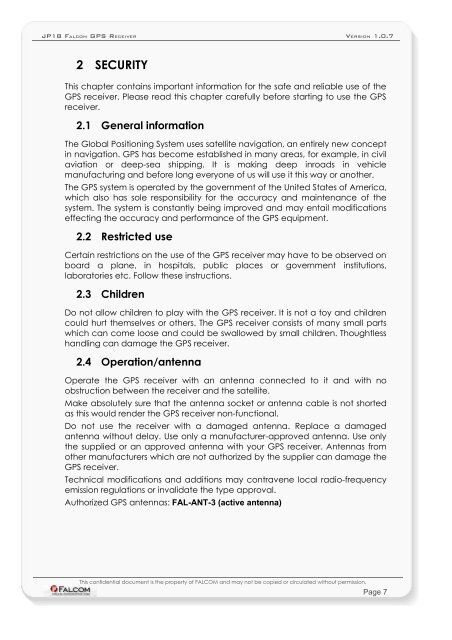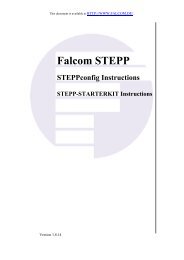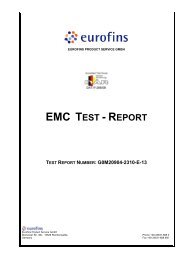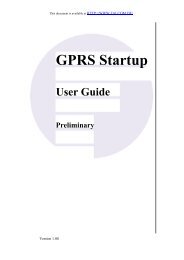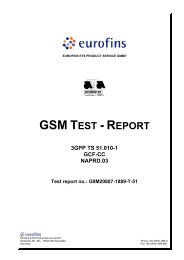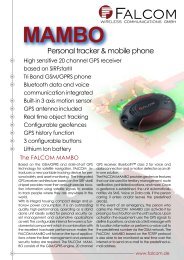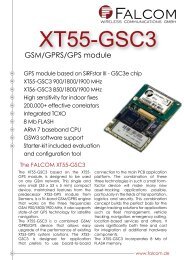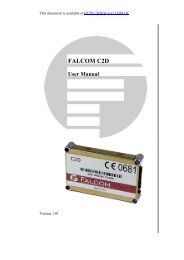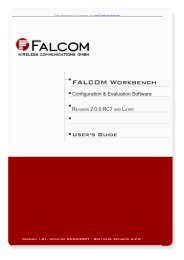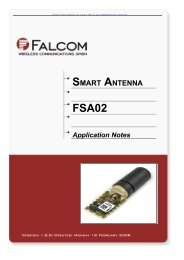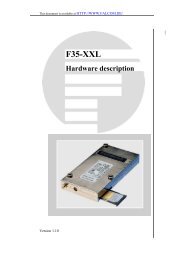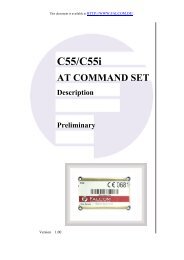FALCOM JP18 GPS receiver - Hardware manual
FALCOM JP18 GPS receiver - Hardware manual
FALCOM JP18 GPS receiver - Hardware manual
Create successful ePaper yourself
Turn your PDF publications into a flip-book with our unique Google optimized e-Paper software.
<strong>JP18</strong> <strong>FALCOM</strong> <strong>GPS</strong> RECEIVER VERSION 1.0.7<br />
2 SECURITY<br />
This chapter contains important information for the safe and reliable use of the<br />
<strong>GPS</strong> <strong>receiver</strong>. Please read this chapter carefully before starting to use the <strong>GPS</strong><br />
<strong>receiver</strong>.<br />
2.1 General information<br />
The Global Positioning System uses satellite navigation, an entirely new concept<br />
in navigation. <strong>GPS</strong> has become established in many areas, for example, in civil<br />
aviation or deep-sea shipping. It is making deep inroads in vehicle<br />
manufacturing and before long everyone of us will use it this way or another.<br />
The <strong>GPS</strong> system is operated by the government of the United States of America,<br />
which also has sole responsibility for the accuracy and maintenance of the<br />
system. The system is constantly being improved and may entail modifications<br />
effecting the accuracy and performance of the <strong>GPS</strong> equipment.<br />
2.2 Restricted use<br />
Certain restrictions on the use of the <strong>GPS</strong> <strong>receiver</strong> may have to be observed on<br />
board a plane, in hospitals, public places or government institutions,<br />
laboratories etc. Follow these instructions.<br />
2.3 Children<br />
Do not allow children to play with the <strong>GPS</strong> <strong>receiver</strong>. It is not a toy and children<br />
could hurt themselves or others. The <strong>GPS</strong> <strong>receiver</strong> consists of many small parts<br />
which can come loose and could be swallowed by small children. Thoughtless<br />
handling can damage the <strong>GPS</strong> <strong>receiver</strong>.<br />
2.4 Operation/antenna<br />
Operate the <strong>GPS</strong> <strong>receiver</strong> with an antenna connected to it and with no<br />
obstruction between the <strong>receiver</strong> and the satellite.<br />
Make absolutely sure that the antenna socket or antenna cable is not shorted<br />
as this would render the <strong>GPS</strong> <strong>receiver</strong> non-functional.<br />
Do not use the <strong>receiver</strong> with a damaged antenna. Replace a damaged<br />
antenna without delay. Use only a manufacturer-approved antenna. Use only<br />
the supplied or an approved antenna with your <strong>GPS</strong> <strong>receiver</strong>. Antennas from<br />
other manufacturers which are not authorized by the supplier can damage the<br />
<strong>GPS</strong> <strong>receiver</strong>.<br />
Technical modifications and additions may contravene local radio-frequency<br />
emission regulations or invalidate the type approval.<br />
Authorized <strong>GPS</strong> antennas: FAL-ANT-3 (active antenna)<br />
This confidential document is the property of <strong>FALCOM</strong> and may not be copied or circulated without permission.<br />
Page 7


